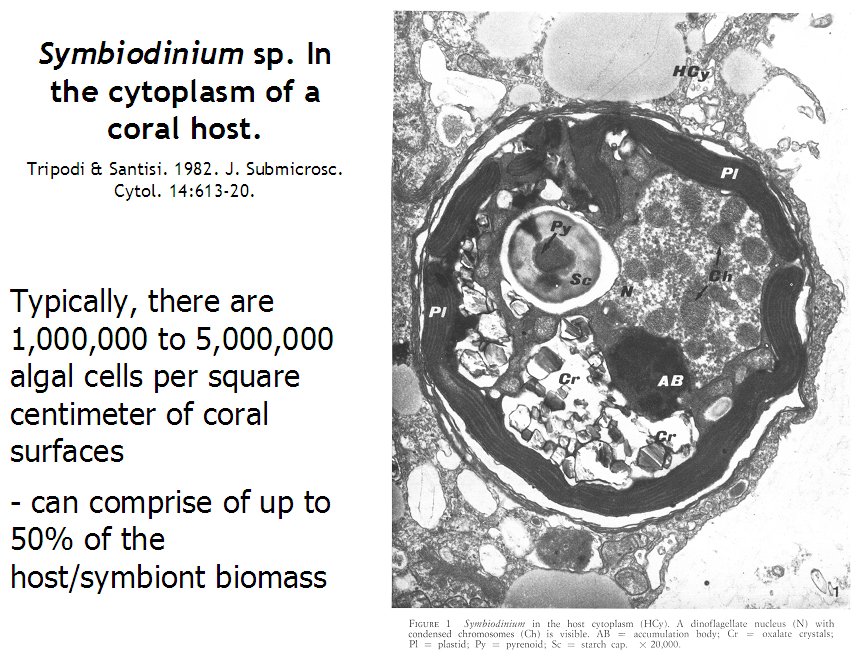Symbiodinium Symbiosis: Difference between revisions
Nicolehebert (talk | contribs) No edit summary |
Nicolehebert (talk | contribs) No edit summary |
||
| Line 4: | Line 4: | ||
=== Species Overview === | === Species Overview === | ||
Symbiodinium | Symbiodinium is a genus of diverse endosymbiotic algae with genus members commonly referred to as zooxanthellae(Blank 1987, van Oppen et al. 2001, and Weis et al. 2001). Being algae, organisms of symbiodinium are autotrophic and eukaryotic, gaining energy from photosynthesis (Blank 1987). Individual cells are coccoid and at times produce flagella to enhance motility (Blank 1987). Zooxanthellae commonly form symbiotic relationships with a variety of marine animals including cnidarians, zoanthids, foraminifers, and jellyfish (Baillie et al. 1999). | ||
Corals | Corals | ||
Revision as of 01:37, 21 November 2011
MicrobeWiki in Process
Species Overview
Symbiodinium is a genus of diverse endosymbiotic algae with genus members commonly referred to as zooxanthellae(Blank 1987, van Oppen et al. 2001, and Weis et al. 2001). Being algae, organisms of symbiodinium are autotrophic and eukaryotic, gaining energy from photosynthesis (Blank 1987). Individual cells are coccoid and at times produce flagella to enhance motility (Blank 1987). Zooxanthellae commonly form symbiotic relationships with a variety of marine animals including cnidarians, zoanthids, foraminifers, and jellyfish (Baillie et al. 1999).
Corals
-examples: Hawaiian stony coral Montipora verrucosa (Blank), stony coral Montipora patula Quelch (Baillie et al), genus Acropora (van Oppen), Fungia scutaria (Weis et al 2001)
- form obligate endosymbiotic relationships with dinoflagellates (van Oppen et al)
- horizontal transmission, many corals produce offspring free of symbiont (azooxanthellate) and must choose symbiont based on what is available in the environment such as F. scutaria with mutualism beginning during larval stage; gametes fertilized in water column; specificity occurs during initiation of symbiosis (Weis et al 2001)
Mutualism
-relationships between host and algal genotypes are unclear (van Oppen et al)
- symbiont lives in host gastrodermal cell vacuoles; symbiont provides photosynthetically fixed carbon while host provides inorganic nutrients, high light environment, and protection from herbivory; without symbiont cnidarians have severely reduced growth, survivorship, and fitness; host is infected while a polyp during the feeding process and phagocytosis by gastrodermal cells; homologous infection is more successful than heterologous strains(Weis et al 2001)
Molecular Underpinnings of the Relationship
-available data are still insufficient to describe the molecular systematics of symbiotic dinoflagellates (Baillie et al)
Evolutionary History
- no evidence of coevolution has been found, but there are light related patterns with distribution (van Oppen et al 2001)
Recent Research
Study Microbes * Microbial Biorealm * Viral Biorealm * Microbial Mythology
MicrobeWiki is a free wiki resource on microbes and microbiology, authored by students at many colleges and universities. Curated pages such as those linked to the Taxonomy Index are reviewed and updated by microbiologists at Kenyon College. Student pages authored independently, or for coursework, are not monitored further. Interested readers are encouraged to add information, after registering a free account.
Study Microbes is a new section of study questions and recommended species for students to learn, based on the textbook Microbiology: An Evolving Science by Joan Slonczewski and John Foster (W. W. Norton & Co.)
Educators: You may assign MicrobeWiki page creation and editing as projects for your students. We create a template page for your assignment, which you may edit to meet your needs. See for example the pages created by the following classes:
- BIOL 238 Class Index 2024, Joan L. Slonczewski,Kenyon College
- Microbial Ecology, Dr. Jay Lennon, Indiana University
- SSC111 Soil Microbiology, Kate Scow, University of California, Davis
- Microbial Ecology, Dr. Hidetoshi Urakawa, Florida Gulf Coast University.
- General Microbiology by Students of Jennifer Bhatnagar, Boston University
Your students receive individual passwords. Assessment and grading are up to you; after your class is over, we review pages for our standards. Students of all levels, from first-year to graduate students, have contributed pages to our site.
MicrobeWiki includes these curated pages:
Microbial Biorealm: encylopedia of bacteria, archaea and eukaryotic microbes. See also Taxonomy Index.
Viral Biorealm: encyclopedia of viruses of animals and plants, and bacteriophages. See also Taxonomy Index.
Microbial Mythology: common misconceptions and controversies in microbiology.
Kristina Buschur, '11, Ryo Tashiro '09, Molly Schlemmer '08, Shrochis Karki '09, Drew Taber3, Allison Whipple '06, Zeva Levine1, Laura Damon-Moore1, Ariel Kahrl2, Hannah Sacks '08, Michael Stulberg '05, Casey M. Smith '06, and Shana Scogin '07
Advisor: Joan Slonczewski, Biology Dept, Kenyon College
Guest editors from 1Beloit, 2Oberlin, and 3Columbia Union College.
Funded by HHMI awards to Kenyon College, 2000, 2004.
Copyright notice. Readers may view, browse, and/or download material for
noncommercial personal purposes. Please credit our site for use. Materials on our site obtained with permission from other sources require permission from those sources
for further reproduction.
Disclaimer. Information on this site is provided solely for educational purposes. Medical questions should be referred to a physician.

